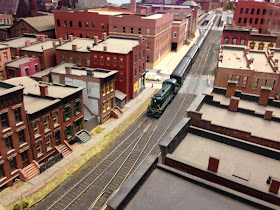The Hartford Rayon Company was, by far, the largest industry on the Valley Line. Located in the
Dividend section of Rocky Hill, it received tank cars of chemicals and shipped boxcars of - you guessed it - rayon. It was especially busy during WWII producing parachutes. But even after the war, with the post-war boom of consumer production & consumption (pantyhose, anyone?), it kept the Valley Local busy with traffic.
As the largest industry, I know the building is going to have to be large. And - typical of anybody's layout - I don't have a
lot of space, so a mockup is absolutely critical. So,
as promised, here's more on the mockup of Hartford Rayon.
Again, I went to BillS for help producing the mockup and - thankfully - he enjoyed the challenge enough to take it on. Unfortunately, he didn't have much to work with as far as prototype photos.
 |
| Hartford Rayon on left, looking south in 1925 - the cool "station" is gone by my era. |
Even though we only had one "historic" photo to go on, the complex is still around today, so I got a few more photos:
 |
| Hartford Rayon, looking southeast |
 |
| Detail of original section |
 |
| Detail of south end offices |
Based on these photos alone, Bill worked his magic and produced the "parts" for the mockup:
 |
| Mockup parts, printed out. |
Then it was just a matter of gluing/laminating the parts to matte board and then cutting them out:
The "cutting out" actually took the longest amount of time, given all the sawtooth roof profile.
The other challenge was that the building is so large that the parts couldn't fit on one sheet. No problem - Bill organized them so they could printout on standard size paper, but I had to join the parts together:
 |
| Scraps make good splices |
Using my handy dandy gluing jig made gluing the corners a lot easier (those gray squares indicate where the jut-out portions of the building will go):
Once all the parts were glued together, I fit it on the layout:
 |
| Shows how large it is in relation to the space, but all that nice trackside detail faces away from the aisle(!) - and there's no roof or back(aisle)side wall. |
Here are a couple more views showing the initial placement on the layout:
 |
| Looking "southwest" |
 |
| Looking "northwest" |
Of course, the lack of a back wall would bug me - even in a mockup - and you can't have a roof without that 4th wall to support it. So, since it was the aisle-side anyway, I decided to just do a plain wall:
 |
| Step 1 was to trace the outline of the front (trackside) wall |
Then cut it out:
Fortunately, the matte board was large enough to do this all in one piece. Unfortunately, there were a LOT of cuts necessary.
Once the back was cut out, I concentrated on adding the building jut-outs:
And then had to cut out, fold, and glue on all those roof sections. But the result was well worth it:
 |
| The completed building - trackside |
 |
| Completed building, back(aisle)side |
 |
| Here's how it looks on the layout |
It's a shame that all that wonderful detail is trackside and hidden from the aisle. I'm tempted to reverse-print the parts again on paper and cut'em out & glue them to the backside for SOMEthing to look at. But then I remind myself that this is "only" a mockup and I shouldn't spend too much time on it.
But taking photos from trackside is pretty cool - even if they're "rare" (impossible) views:
 |
| Looking "northeast" with the old Billings & Spencer building (now - in 1947 - a warehouse for Hartford Rayon) in the background |
And here's the prototype comparison shot - again, unfortunately, not easily viewed under normal circumstances:
Not too bad at all - at least for now!

































